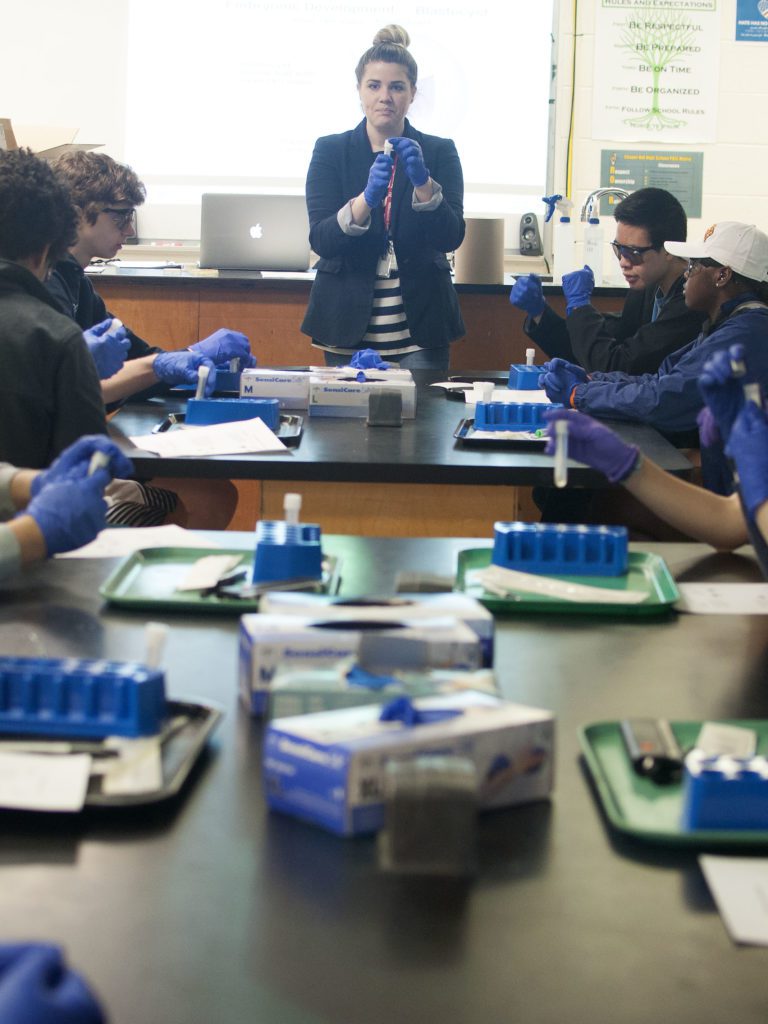 CHAPEL HILL ‒ As a biomedical science teacher, I facilitate experiential learning for a group of creative, curious students at Chapel Hill High School. I am always looking for ways to grow my content knowledge and expand my educator toolbox, which is why I decided to become a Kenan Fellow.
CHAPEL HILL ‒ As a biomedical science teacher, I facilitate experiential learning for a group of creative, curious students at Chapel Hill High School. I am always looking for ways to grow my content knowledge and expand my educator toolbox, which is why I decided to become a Kenan Fellow.
Last summer, I had the opportunity to work with a team of innovative stem cell research scientists at NC State University, where I spent three weeks exploring the inner workings of a laboratory as a 2017-218 Kenan Fellow. Reflecting on my one-year fellowship, I now I feel more confident delivering content and explaining modern applications of techniques, and I have a much wider breadth of information about potential career paths to share with students.
As I teach, I find myself frequently remembering and sharing things I’ve learned during my internship – from my mentors, my NC State mentors, Dr. Balaji Rao and Dr. Stefano Menegatti ‒ during my time in the lab, or during my research. Overall, I learned a great deal about stem cell potential, history and policy. I now have a much better understanding of how stem cells are currently being used in medicine and where research is headed. There are many learning objectives in the biomedical science courses I teach that connect with stem cell research, and I have enjoyed integrating my new knowledge into my teaching.
‘Real world’ Learning
Having spent minimal time in an academic or professional lab, I wasn’t quite sure what to expect from or how it would relate to my students. But even after a brief period lab, I not only practiced many of the skills biomedical science students gain, but I learned about many more real-world applications for those skills. I also learned new skills that have given me a greater understanding of the ultimate purpose of the techniques that my students learn.
It was challenging but ultimately I was able to develop a unit that can be used by teachers across the country to allow their students to gain a multi-faceted, thorough understanding of stem cell research technology, history, and policy. The five-lesson unit tasks students with developing a mock biotechnology company whose goal is to address a human health issue using a stem cell technology. Students work in groups to create a presentation about their company and its objectives for a group of stakeholders. As part of their presentations, they must address current legal and ethical requirements of stem cell research.
Building Leadership Capacity
In addition to strengthening my skills as an educator, this experience has inspired me to take a more active leadership role in my school. I want to inspire other teachers to embrace their students, their content, and their influence on future STEM-focused citizens.
I have made it a point to share new knowledge and contacts with my fellow biomedical science teachers and in the future, I hope to seek out and create more opportunities to reach out to my colleagues and share the awesome ideas and strategies that I learned, during my internship and the Kenan Fellows Program Professional Learning Institutes.
The connections I have forged with phenomenal educators around the state and the knowledge of the world of research that I have gained from this experience have given me the skills and confidence needed to introduce my students to the many opportunities available in STEM fields. No other professional development I have participated in has been so relevant to my current teaching reality.
Clare Matusevich is a 2017-18 Kenan Fellow. She teaches at Chapel Hill School in Chapel Hill-Carrboro Schools. Her fellowship was supported by NC State University and the Merck Foundation.